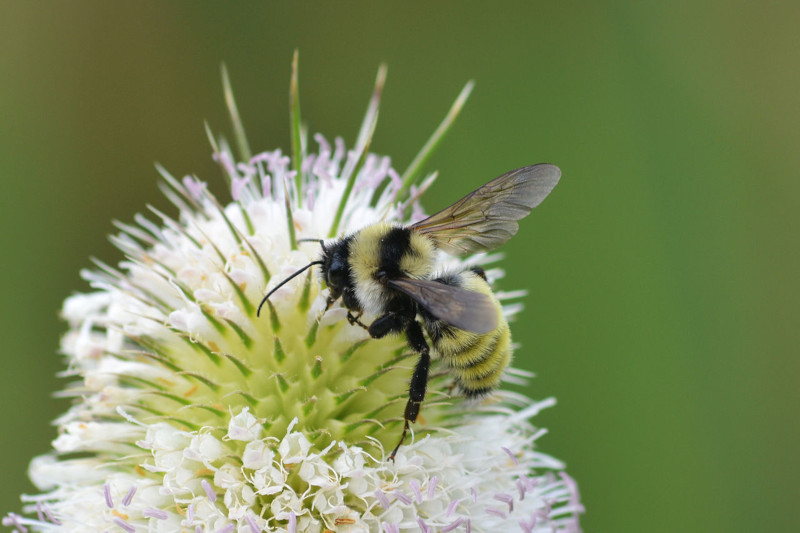Golden Northern Bumblebee Facts
- The perfectly descriptive term Golden Northern Bumblebee serves as the common name for a particularly beautiful variety of bumblebee. Yet, this highly fascinating small invertebrate also bears another title. That’s the distinctive scientific name of the Bombus fervidus.
- By either name, though, the captivating small creature remains an impressive species. Fascinatingly, within its native range, it also remains an important pollinator. The natural wonder also represents on of the very first in its zone of habitation to be identified.
- This occurred through the efforts of the well-known Danish zoologist Johan Christian Fabricius, in 1798. The marvelous insect also displays some quite fascinating behavioral patterns. This even apparently includes a communication system based on dancing.
- This incredible product of Nature and evolution also developed a program of highly specialized nest defense strategies for different categories of intruders. When intrusions into the nest occur, multiple members move to cover the intruder with honey to hamper its movement.
- Like many species of bees found around the world, the population of the Golden Northern Honeybee sadly appears to be declining rapidly. The IUCN currently lists it as Vulnerable, as a result. This listing appears on the organization’s Red List of Threatened Species.
- This highly lamentable and rapid reduction in population appears to be occurring due to a variety of factors. While these include habitat loss, it’s also threatened by the ongoing and escalating effects of climate change, much like many other species around the world.
Related Articles
Golden Northern Bumblebee Physical Description
Surprisngly, perhaps, the wonder of the Golden Northern Bumblebee does not extend to size. In fact, it actually constitutes a small variety of bumblebee. Sexual dimorphism plays a factor as well. Female workers reach 0.75 in (1.9 cm) in length, while male drones only average 0.5 in (1.3 cm).
This small but truly beautiful example of its kind also displays this gender-based differentiation in another way. Intriguingly, the wingspan appears to be sex-related in this particular arthropod. That particular manifestation of the evolutionary principle easily sets it apart from numerous others.
The wings of a female of the species measure an average of approximately 1.6 in (40 mm) in overall span. However, that of the males only averages a measurement of roughly 0.86 in (22 cm). This represents a quite significant difference for a species of its size. Exceptions occur, but rarely.
This wonder of Nature’s also quite well known for its dazzling appearance, which never fails to please the eye. Its coloring usually appears as a combination of black and golden yellow. In yet another gender-based difference, though, the male typically displays more yellow than the female.
In other respects, though, individuals of both genders appear remarkably similar. The body of both evolved as covered with numerous comparatively short, but thick, hairs. The amazing Golden Northern Bumblebee also distinguishes itself from the smaller honeybee in an important way.
Impressively, unlike the even smaller honeybee, this remarkable species does not die after inflicting a sting. In point of fact, the impressive invertebrate has the ability to repeatedly attack an opponent with its stinger. This action rarely forms a danger to humans, however, unless one’s allergic.
- Kingdom: Animalia
- Phylum: Arthropoda
- Class: Insecta
- Order: Hymenopterta
- Family: Apidae
- Genus: Bombus
- Species: B. fervidus
Golden Northern Bumblebee Distribution, Habitat, and Ecology
The serenely beautiful Golden Northern Bumblebee developed as endemic to only a specific section of the globe, like many of its many relatives. More specifically, however, that native region consists solely of somewhat limited and restricted portions of the continent of North America.
Within that greater overall zone of habitation, its populations primarily concentrate in scattered portions of that continent. The fascinating arthropod most commonly appears in the northeastern portion of the United States, where it generally distinguishes itself from competing species.
Fortunately, the marvelous Arthropod displays a moderately high degree of flexibility in its choice of habitat. It’s thus found in a fairly wide variety of ecosystems. Each of these nevertheless do share certain conditions that serve to meet the insect’s particular natural requirements.
It’s frequently spotted in open, sunny areas of grasslands. Such settings typically include both wet and dry meadows, where flowering plants appear in abundance. It’s also common to the transition zones between forests and open areas, often with plenty of wildflowers, shrubs, and trees.
Interestingly, the intrepid creature further displays a fondness for higher elevations. There, either alpine meadows or subalpine habitats serve to provide suitable conditions. Yet, it does show some adaptability. It’s also occasionally present in or near agricultural areas, especially among hedgerows.
It also further sets itself apart from most other bumblebees in terms of its housing. Flexibly, the nests of this particular creation of Nature occur both underground and above. These the highly skilled bee commonly constructs out of a loose mass of grass held together with avian feces.
Adult specimens of the Golden Northern Bumblebee feed entirely on the nectar of various flowering plants. A wide variety of locally abundant flora serve. They play the pivotal role of important pollinators and are attracted to flowers such as clover, willow, and various other wildflowers.
In contrast, the young of the species are fed pollen collected by the workers of the colony. Nest populations also generally remain quite small. Amazingly, that number rarely exceeds sixty adults and pupae. Lifespans range from 34 days for workers to roughly 12 months for the queen.
Species Sharing Its Range
Check out our other articles on Fabulous Herbaceous Plants Named After Animals, Pesquet’s Parrot, Havasu Falls, Long-Finned Pilot Whale, East African Lowland Honey Bee, Black Caiman

